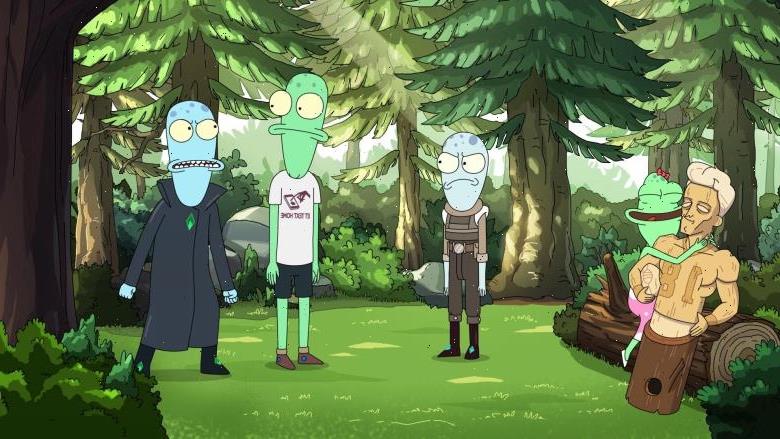It isn’t often that a subplot overtakes the plot in prominence, but that’s what makes “Solar Opposites” uniquely fun and ambitious. Hulu’s adult-oriented animated sitcom from “Rick and Morty” co-creator Justin Roiland and Mike McMahan (“Star Trek: Lower Decks”) basically gives you two shows in one: a sci-fi sitcom about a race of aliens stranded in middle America, and a serial adventure about the humans they shrink that are imprisoned inside the Wall.
And, in Season 2, the Wall turns into a “True Detective”-like conspiracy thriller involving power, corruption, and murder within the fledgling micro society.
Thus, it’s no accident that both Wall episodes from Season 1 (“Terry and Korvo Steal a Bear”) and Season 2 (“The Unlikely Demise of Terry’s Favorite Shot Glass”) were submitted by Hulu for Emmy consideration. Fans and critics alike are fascinated by the parallel story about totalitarianism. “We were having so much fun with the Wall in the first season that it would’ve been a big swing and a miss if people didn’t get on board with it,” McMahan said. “And it helped that it dropped all at once and people saw it really quick through bingeing.”
Originally, the idea was to have a different standalone show within the show every season, but the creators became so enamored with the Wall that they decided instead to explore its evolution as a parallel universe. In Season 1, the setup was dystopian and totalitarian with the Duke (Alfred Molina) killed by resistance leader Tim (Andy Daly). But when Tim’s companion, Benihana chef Cherie (Christina Hendricks), questions his corrupt power grab, he stabs her and throws her out of the Wall.
“Solar Opposites”
Hulu
In Season 2, Cherie discovers that the Duke actually escaped back into the outside world, and these sworn enemies team up to combat giant rodents. They even begin bonding after she realizes she’s pregnant and Tim’s the father. The Duke even helps her give birth in the bottom of a Pez dispenser. Cherie then makes it back to the Wall with her baby and plots with Halk (Sterling K. Brown), a traumatized resistance-fighter-turned detective, to take down Tim.
“Because of the freedom we have on Hulu, we’re pushing the boundaries of an animated sitcom, whether it’s language or sexual content or onscreen violence,” McMahan said. “We’ve actually put together a working society inside the Wall that has a colorful darkness, except there are undercurrents that are being covered up that make it a bit of a ‘Stepford’ situation. Getting to explore those cracks through his new character, Halk, in Season 2, and putting it in the ‘True Detective’ sort of narrative was a different way to tell a mythologically broad story about violence in society. Multiple people died in a Nerds avalanche and Halk is consumed by it the way Matthew McConaughey was consumed in ‘True Detective.’”
For executive producer and writer Josh Bycel, it got very strange spotting a Wall similarity in Hulu’s “The Handmaid’s Tale.” “When someone gets out of [Gilead] and is standing in a grocery store at a wall with all the choices, it reminded me of something we have coming up as well,” he said. “It was literally the exact same shot. From the beginning, we have known what we wanted every Wall season to be. In fact, we had an idea and Mike said, ‘No, no, no, that’ll be in Season 4.’”
Meanwhile, the main “Solar” story keeps evolving as well, with scientist Korvo (Justin Roiland) still trying to leave Earth and buddy Terry (Thomas Middleditch) finding new ways to fit in, and the destruction heaped on humans that results from out-of-control experiments. In Season 2, an angry Korvo outlaws dinner parties and mischievous replicant Yumyulack (Sean Giambrone) creates deadly hounds that devour humans and poop them into bottles of Pino. That is, until the humans return to normal. “The stakes for The Solars are comedic and they reset every episode like a sitcom,” McMahan said. “It’s fun for us to juxtapose a heavily serialized story within a sitcom. The stakes in the Wall have to have a permanence and they have to be dramatic.”
“Solar Opposites”
Hulu
But the stakes began to change for the Solars in Season 2 as well. “We were thinking why these aliens don’t experience repercussions,” said McMahan. “The Solars don’t think of humans having agency or being equals. These aliens can die and regrow. But there’s the [infant] Pupa [Sagan McMahan] element that’s growing and is going to consume them and terraform the planet, and, in Season 3, we will start to serialize the non-serialized elements.”
Yet, for all the ambition associated with the Wall, there needs to be a balance. You still need the cartoon absurdity of the Solars to make the series work. “Some of the reaction on Twitter has been a desire to have it all be about the Wall,” Bycel said. “I don’t think you do. It’s there to serve a purpose. Any more and it won’t play as well. We’re always cognizant of the right amount.”
At the same time, the Wall must keep us guessing about what happens next. “Not to give away any spoilers, but I think people are going to be surprised by who doesn’t get corrupted inside the Wall in Season 3,” McMahan said. “It’s like a ‘SparkNotes’ version of a drama. It’s fun to distill it down and write epic scenes with the constant internal comedy of surviving on M&Ms and sleeping under LEGOS.”
“Solar Opposites” is streaming now on Hulu.
Source: Read Full Article




